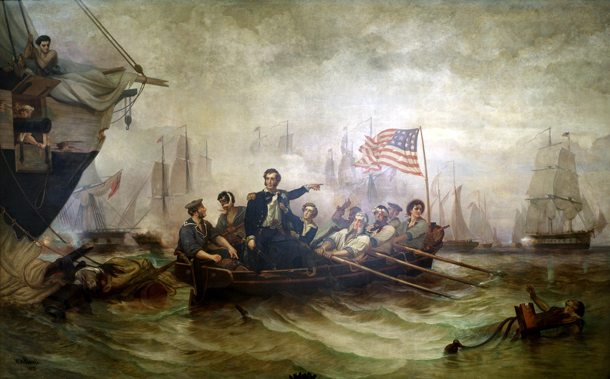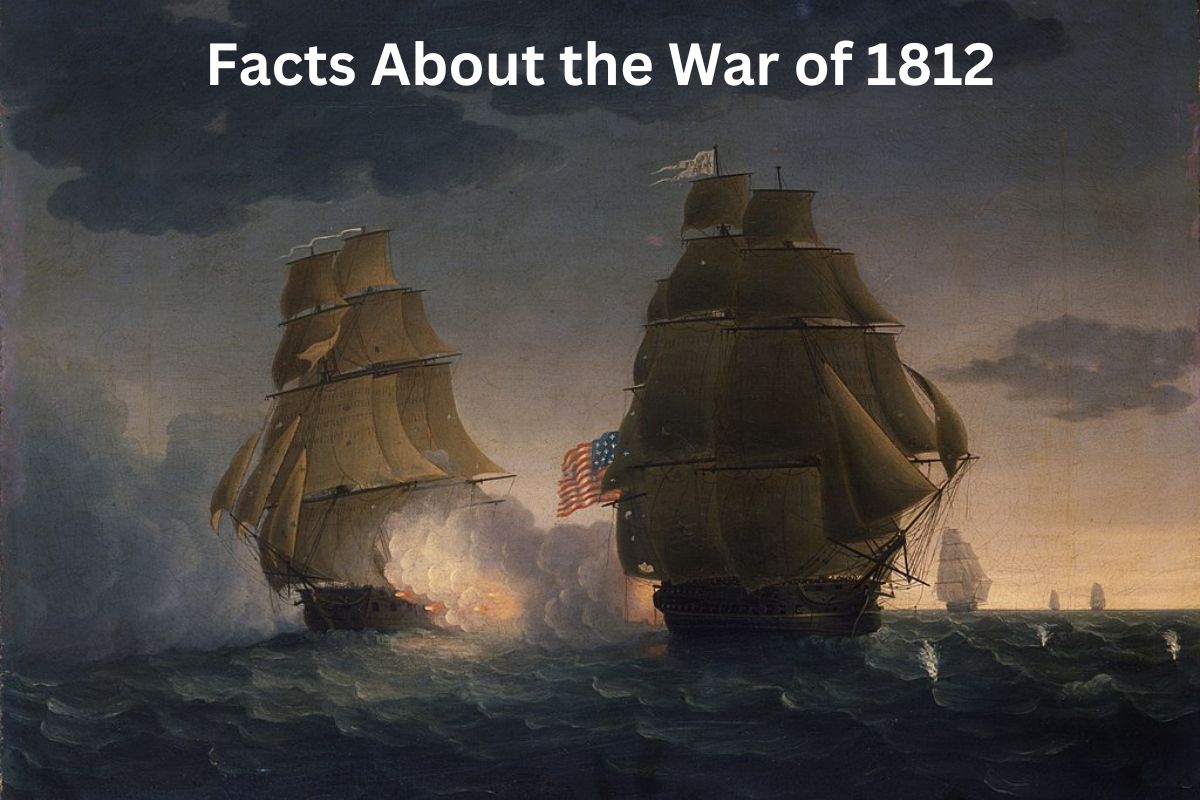The War of 1812 was a conflict fought between the United States and Great Britain from 1812 to 1815. It arose primarily due to British trade restrictions imposed on the United States during the Napoleonic Wars and British support for Native American resistance to American westward expansion.
It encompassed various theaters, including the Great Lakes region, the Atlantic Ocean, and the Gulf Coast. While the United States sought to invade Canada initially, the British successfully defended their territories and launched counteroffensives into American soil.
The war witnessed notable events, such as the burning of Washington, D.C., and the composition of the American national anthem, “The Star-Spangled Banner.” Ultimately, the conflict ended with the signing of the Treaty of Ghent in 1814, which restored pre-war boundaries between the two nations.
The War of 1812 had significant implications for American national identity, westward expansion, political parties, and the economy.
War of 1812 Facts
1. The War of 1812 was fought between the United States and Great Britain from 1812 to 1815
The War of 1812 was primarily caused by trade restrictions imposed by Britain on the United States during the Napoleonic Wars. Britain, as a dominant naval power, sought to impede American trade with France and its allies.
Also Read: Wars of the 19th Century
The British implemented a series of Orders in Council that restricted American shipping and forced American vessels to obtain licenses and pay fees for trading with Europe.
Additionally, British impressment of American sailors, where they were forcibly enlisted into the British Navy, was a major point of contention for the United States.

2. One of the key events that triggered the war was the British practice of impressment
The issue of impressment played a significant role in the outbreak of the war. The British Navy, facing a shortage of sailors, began stopping American ships on the high seas and seizing suspected British deserters.
Also Read: War of 1812 Timeline
However, they often captured American citizens who were claimed to be British deserters.
This practice violated American sovereignty and sparked outrage among the American public and policymakers. The United States demanded an end to impressment and the recognition of its maritime rights as a neutral nation.
3. The war was fought on multiple fronts, including the Great Lakes region, the Atlantic Ocean, and the Gulf Coast
The war was fought on multiple fronts. In the Great Lakes region, both the United States and Britain sought control over key waterways and territories. The American plan involved invading Canada, believing that British control of Canada was a threat to American security.
Also Read: History of Canada Facts
However, the American military efforts to capture Upper Canada (present-day Ontario) failed, and the British successfully defended their territories, primarily through the leadership of Major General Isaac Brock and Tecumseh, a Native American leader who allied with the British.
The British also launched counteroffensives, including the successful invasion of Washington, D.C., and the burning of the White House and other government buildings in August 1814.
4. The British military was initially occupied with the Napoleonic Wars in Europe
The British military was initially preoccupied with the Napoleonic Wars in Europe, which allowed the United States to gain some early victories. With Britain engaged in a protracted conflict against Napoleon Bonaparte’s forces, the American military saw an opportunity to assert itself.
American naval successes, such as the USS Constitution’s victories against British ships, bolstered American morale and demonstrated the capability of the young nation’s navy.
However, once Napoleon was defeated and the European war came to an end in 1814, Britain was able to redirect its resources and focus more attention on the conflict with the United States.
5. The war witnessed several notable battles and events
The War of 1812 witnessed several significant battles and events that left lasting impressions on both sides.
The Battle of Lake Erie, fought on September 10, 1813, was a pivotal naval engagement in which the American fleet, commanded by Commodore Oliver Hazard Perry, achieved a decisive victory over the British.
Perry famously declared, “We have met the enemy and they are ours,” after capturing the entire British squadron. The American triumph secured control of the Great Lakes and boosted American confidence.
Another notable event was the burning of Washington, D.C., by British forces in retaliation for the American burning of York (present-day Toronto) earlier in the war.
In August 1814, British troops marched into Washington and set fire to numerous government buildings, including the White House and the Capitol. This act of destruction shocked and humiliated the Americans but did not significantly alter the outcome of the war.

6. The national anthem of the United States, “The Star-Spangled Banner,” was written during the War of 1812
One enduring legacy of the War of 1812 is the composition of the American national anthem, “The Star-Spangled Banner.” The lyrics were written by Francis Scott Key during the Battle of Baltimore in September 1814. Key was inspired by the American defense of Fort McHenry against a British naval bombardment.
After a night of intense shelling, Key observed the American flag still flying above the fort at dawn, signaling American resilience and victory.
He penned the poem “Defence of Fort M’Henry,” which later became the lyrics of the national anthem. “The Star-Spangled Banner” was officially recognized as the national anthem of the United States in 1931.
7. The war saw significant involvement from Native American tribes, many of whom sided with the British
Native American involvement in the War of 1812 was significant. Many Native American tribes saw the conflict as an opportunity to resist American westward expansion and maintain their territories.
The British, aiming to undermine American efforts, provided support, arms, and supplies to various tribes, including the Shawnee under the leadership of Tecumseh.
Tecumseh’s alliance with the British was based on a vision of a unified Native American confederacy that would counter American expansion.
Native American forces fought alongside British troops in several key battles, including the Battle of the Thames in 1813, where Tecumseh was killed.
The defeat of the Native American-British alliance weakened the resistance against American expansion into the western territories.
8. The Treaty of Ghent, signed on December 24, 1814, effectively ended the war
The Treaty of Ghent, signed on December 24, 1814, effectively ended the war. The negotiations took place in Ghent, Belgium, between American and British diplomats.
The treaty restored pre-war boundaries between the United States and British North America (Canada) without significant territorial changes. It also established a commission to address unresolved boundary disputes and impressment claims.
The Treaty of Ghent is considered a diplomatic victory for the United States as it halted the fighting and brought stability to the region. Importantly, it set the stage for a peaceful relationship between the United States and Britain in subsequent years.
9. Despite the treaty being signed in December 1814, the news of the peace took several weeks to reach North America
Despite the signing of the treaty, the news of peace took several weeks to reach North America due to the slower means of communication at the time. This delay led to the Battle of New Orleans, which took place on January 8, 1815.
Also Read: Facts About the Battle of New Orleans
British forces, unaware that the war had ended, launched a major assault on American positions defended by General Andrew Jackson and his troops. The American defenders, well-prepared and utilizing advantageous positions, inflicted heavy casualties on the British forces, resulting in a resounding American victory.
Although the battle had no impact on the outcome of the war itself, it became a celebrated event in American history, boosting national pride and enhancing Jackson’s reputation as a military leader.
10. The War of 1812 had significant long-term consequences
The War of 1812 had significant long-term consequences for both the United States and Britain. It contributed to the growth of American national identity and a sense of pride as the young nation successfully defended its sovereignty against a powerful European power.
The war became a defining moment in American history, solidifying the notion of American exceptionalism and the belief in Manifest Destiny, which fueled the subsequent westward expansion.
Furthermore, the war had political consequences. It marked the decline of the Federalist Party, which had opposed the war, as their opposition to the conflict was perceived as unpatriotic. The Democratic-Republican Party, led by President James Madison, emerged stronger, and the nation became more politically unified.
Economically, the war disrupted trade between the United States and Europe, leading to a greater emphasis on domestic manufacturing and industrialization. The war stimulated American industries to produce goods that were previously imported, thus promoting economic self-sufficiency and the growth of a manufacturing base.
